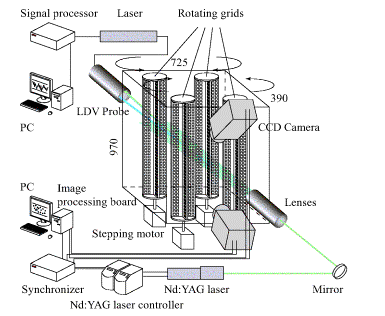
Generation of nearly isotropic homogeneous turbulence using rotating grids
Nearly isotropic homogeneous turbulence without mean flow is used as an ideal flow field in basic researches of turbulence because it is analyzed theoretically easily. Traditionally, turbulence has been often generated using wind tunnel in experimental researches. However, large mean flow and apparatus are needed to generate strong turbulence and it is not easy to obtain spatially homogeneous turbulent intensity.
Recently, several researches reported that oscillating grids or rotating grids can generate more isotropic turbulent field despite of their small available area.
In this study, an apparatus including four rotating grids shown in Fig.1 is used to generate fluctuation of air flow the grids. Flow filed is measured with Particle Image velocimetry (PIV) to obtain spatial distribution of velocity, and with Laser Doppler Velocimetry (LDV) to obtain velocity fluctuation at a high time resolution.

Fig.1 Schematics of experimental setup

Fig.2 Turbuilent statistics and energy spectrum
Distribution of turbulent intensity along vertical direction in the center of apparatus is shown in the left of fig.2. Turbulent intensity can be adjusted arbitrary by changing rotating speed of grids. Energy spectrum of fluctuation velocity indicates that the flow field has certain characteristics of turbulence.
In the future, following experiments are expected using this flow field: diffusion of solid particles dispersed in the fluid at various volume fractions, or locus tracing of dispersed phase.
References
- Srdic A., Fernando H. J. S. and Montenegro L., “Generation of nearly isotropic turbulence using two oscillating grids”, Experiments in Fluids, Vol. 20, (1996), pp 395-397.
- Friedman P. D. and Katz J., “Mean rise rate of droplets in isotropic turbulence”, Phys. Fluids, Vol. 14, (2002) pp 3059-3073.
- Muto M., Ushijima T., Oshima N., Oshima M. and Kobayashi T., “Flow field statistics of nearly isotropic turbulence generated using rotating grids”, Proceedings of 9th Asian Symposium on Visualization (2007).



